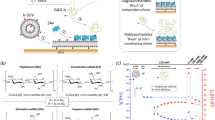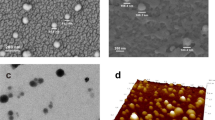Abstract
Atherosclerosis has received wide attention as a primary cause of premature death in developed countries. The retention of low-density lipoprotein (LDL) particles in the intima, the inner layer of the capillaries, has been imputed as the main cause of the development of atherosclerotic plaques. The entrapment of LDL is mainly due to the specific interaction between the lysine-rich site on apolipoprotein B-100 (apoB-100), a major apolipoprotein of LDL, and extracellular matrix (ECM) components such as collagen, proteoglycans, and glycosaminoglycans (GAGs). Although valuable techniques already exist for studies on apoB-100 and ECM interactions, there is continued need for miniaturized tools that can complement the tools already available and even provide totally new data. This work explores the applicability of the quartz crystal microbalance (QCM) for interaction studies between apoB-100 peptide fragments and various components of the ECM. Two positive peptide fragments, PP and PP2, and two components of the ECM, collagen I and a selected GAG, chondroitin 6-sulfate (C6S), were immobilized on polystyrene and carboxyl sensor chips. C6S was injected as analyte for PP- and PP2-coated surfaces, while PP was the analyte for collagen I and C6S surfaces. The estimated dissociation constant (K D) indicates that the interactions occur via the positive residues, lysine and arginine, of apoB-100. The continuous-flow QCM system employed in this study is shown to be an excellent tool for the elucidation of interactions between these types of biomolecules.

Binding of PP to a C6S aldehyde coupled carboxyl crystal. PP concentrations ranged from 50 to 250 µg/mL. Running buffer: PBS pH 7.4. Flow rate: 25 µL/min. Experiments were carried out at room temperature




Similar content being viewed by others
References
Biggerstaff KD, Wooten JS (2004) Understanding lipoproteins as transporters of cholesterol and other lipids. ADV Physiol Educ 28:105–106
Castellani WJ (2004) Metabolic and nutritional aspects of the atherogenic atypical lipoproteins: lipoprotein(a), remnant lipoproteins, and oxidized low-density lipoprotein. Nutr Res 24:681–693
Hevonoja T, Pentikäinen MO, Hyvönen MT, Kovanen PT, Ala-Korpela M (2000) Structure of low density lipoprotein (LDL) particles: basis for understanding molecular changes in modified LDL. Biochim Biophys Acta 1488:189–210
Yang C-Y, Chen S-H, Gianturco SH, Bradley WA, Sparrow JT, Tanimura M, Li W-H, Sparrow DA, Deloof H, Rosseneu M, Lee F-S, Gu Z-W, Gotto AM Jr, Chan L (1986) Sequence, structure, receptor-binding domains and internal repeats of human apolipoprotein B-100. Nature 323:738–742
Segrest JP, Jones MK, De Loof H, Dashti N (2001) Structure of apolipoprotein B-100 in low density lipoproteins. J Lipid Res 42:1346–1367
Wight TN (1989) Cell biology of arterial proteoglycans. Arteriosclerosis 9:1–20
Skålén K, Gustafsson M, Rydberg EK, Hultén LM, Wiklund O, Innerarity TL, Borén J (2002) Subendothelial retention of atherogenic lipoproteins in early atherosclerosis. Nature 417:750–754
Kadler KE, Holmes DF, Trotter JA, Chapman JA (1996) Collagen fibril formation. Biochem J 316:1–11
Chan VC, Ramshaw JAM, Kirkpatrick A, Beck K, Brodsky B (1997) Positional preferences of ionizable residues in Gly-X-Y triplets of the collagen triple-helix. J Biol Chem 272:31441–31446
Kovanen PT, Pentikäinen M (1999) Decorin links low-density lipoproteins (LDL) to collagen: a novel mechanism for retention of LDL in the atherosclerotic plaque. Trends Cardiovasc Med 9:86–91
Pentikäinen MO, Öörni K, Lassila R, Kovanen PT (1997) The proteoglycan decorin links low density lipoproteins with collagen type I. J Biol Chem 272:7633–7638
Albertini R, Moratti R, De Luca G (2002) Oxidation of low-density lipoprotein in atherosclerosis from basic biochemistry to clinical studies. Curr Mol Med 2:579–592
Öörni K, Pentikäinen MO, Ala-Korpela M, Kovanen PT (2000) Aggregation, fusion, and vescicle formation of modified low density lipoprotein particles: molecular mechanisms and effects on matrix interactions. J Lipid Res 41:1703–1714
D’Ulivo L, Yohannes G, Öörni K, Kovanen PT, Riekkola M-L (2007) Open tubular capillary electrochromatography: a new technique for in situ enzymatic modification of low density lipoprotein particles and their protein-free derivatives. Analyst 132:989–996
Borén J, Olin K, Lee I, Chait A, Wight TN, Innerarity TL (1998) Identification of the principal proteoglycan-binding site in LDL. J Clin Invest 101:2658–2664
Olsson U, Camejo G, Bondjers G (1993) Binding of a synthetic apolipoprotein B-100 peptide and peptide analogs to chondroitin 6-sulfate: effects of the lipid environment. Biochemistry 32:1858–1865
Boren J, Lee I, Zhu W, Arnold K, Taylor S, Innerarity TL (1998) Identification of the low density lipoprotein receptor-binding site in apolipoprotein B100 and the modulation of its binding activity by the carboxyl terminus in familial defective apo-B100. J Clin Invest 101:1084–1093
Camejo G, Olofsson S-O, Lopez F, Carlsson P, Bondjers G (1988) Identification of Apo B-100 segments mediating the interaction of low density lipoproteins with arterial proteoglycans. Arterioscler Thromb Vasc Biol 8:368–377
Camejo G, Hurt-Camejo E, Wiklund O, Bondjers G (1998) Association of apo B lipoproteins with arterial proteoglycans: pathological significance and molecular basis. Atherosclerosis 139:205–222
Iverius P-H (1972) The interaction between human plasma lipoproteins and connective tissue glycosaminoglycans. J Biol Chem 247:2607–2613
D’Ulivo L, Witos J, Öörni K, Kovanen PT, Riekkola M-L (2009) Capillary electrochromatography: a tool for mimicking collagen surface interactions with apolipoprotein B-100 peptides. Electrophoresis 30:3838–3845
Marx KA (2003) Quartz crystal microbalance: a useful tool for studying thin polymer films and complex biomolecular systems at the solution–surface interface. Biomacromolecules 4:1099–1120
Pei Z, Larsson R, Aastrup T, Anderson H, Lehn J-M, Ramström O (2006) Quartz crystal microbalance bioaffinity sensor for rapid identification of glycosyldisulfide lectin inhibitors from a dynamic combinatorial library. Biosens Bioelectron 22:42–48
Pei Y, Yu H, Pei Z, Theurer M, Ammer C, Andr S, Gabius H-J, Yan M, Ramström O (2007) Photoderivatized polymer thin films at quartz crystal microbalance surfaces: sensors for carbohydrate–protein interactions. Anal Chem 79:6897–6902
Kuldvee R, D’Ulivo L, Yohannes G, Lindenburg PW, Laine M, Öörni K, Kovanen P, Riekkola M-L (2006) Open tubular capillary electrochromatography: technique for oxidation and interaction studies on human low-density lipoproteins. Anal Chem 78:2665–2671
Ruiz-Jiménez J, Kuldvee R, Chen J, Öörni K, Kovanen P, Riekkola M-L (2007) Open tubular CE for in vitro oxidation studies of human very-low-density lipoprotein particles. Electrophoresis 28:779–788
Vainikka K, Chen J, Metso J, Jauhiainen M, Riekkola M-L (2007) Coating of open tubular capillaries with discoidal and spherical high-density lipoprotein particles in electrochromatography. Electrophoresis 28:2267–2274
Pei Z, Anderson H, Aastrup T, Ramström O (2005) Study of real-time lectin-carbohydrate interactions on the surface of a quartz crystal microbalance. Biosens Bioelectron 21:60
Jacquemart I, Pamula E, De Cupere VM, Rouxhet PG, Dupont-Gillain CC (2004) Nanostructured collagen layers obtained by adsorption and drying. J Colloid Interface Sci 278:63–70
Elliot JT, Halter M, Plant AL, Woodward JT, Langenbach KJ, Tona A (2008) Evaluating the performance of fibrillar collagen films formed at polystyrene surfaces as cell culture substrates. Biointerphases 3:19–28
Myszka DG, Morton TA (1998) Clamp: a biosensor kinetic data analysis program. Trends Biochem. Sci 23:149–150
Muratsugu M, Ohta F, Miya Y, Hosokawa T, Kurosawa S, Kamo N, Ikeda H (1993) Quartz crystal microbalance for the detection of microgram quantities of human serum albumin: relationship between the frequency change and the mass of protein adsorbed. Anal Chem 65:2933–2937
Sauerbrey G (1959) The use of quartz crystal oscillators for weighing thin layers and for micro-weighing. Z Phys 155:206–222
Melles E, Anderson H, Wallinder D, Shafqat J, Bergman T, Aastrup T, Jörnvall H (2005) Electroimmobilization of proinsulin C-peptide to a quartz crystal microbalance sensor chip for protein affinity purification. Anal Biochem 341:89–93
Godber B, Thompson KSJ, Rehak M, Uludag Y, Kelling S, Sleptsov A, Frogley M, Wiehler K, Whalen C, Cooper MA (2005) Direct quantification of analyte concentration by resonant acoustic profiling. Clin Chem 51:1962–1972
Anderson H, Jönsson M, Vestling L, Lindberg U, Aastrup T (2007) Quartz crystal microbalance sensor design I. Experimental study of sensor response and performance. Sens Actuators B Chem 123:27–34
Acknowledgments
We are grateful to Dr. Teodor Aastrup from Attana AB, Stockholm, Sweden and to Professor Petri T. Kovanen and Dr. Katariina Öörni from Wihuri Research Institute, Helsinki, Finland for valuable discussions and comments. Financial support was provided by CHEMSEM Graduate School (L.D.), the Research Council for Natural Sciences and Engineering, the Academy of Finland under grants 116288 (M.-L.R. and L.D.), and a Research Grant from the University of Helsinki (M.-L.R).
Author information
Authors and Affiliations
Corresponding author
Rights and permissions
About this article
Cite this article
D’Ulivo, L., Saint-Guirons, J., Ingemarsson, B. et al. Quartz crystal microbalance, a valuable tool for elucidation of interactions between apoB-100 peptides and extracellular matrix components. Anal Bioanal Chem 396, 1373–1380 (2010). https://doi.org/10.1007/s00216-009-3371-y
Received:
Revised:
Accepted:
Published:
Issue Date:
DOI: https://doi.org/10.1007/s00216-009-3371-y




